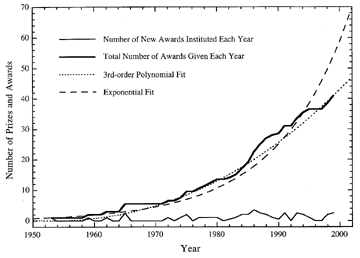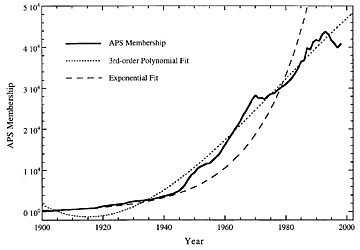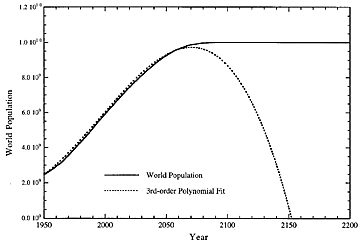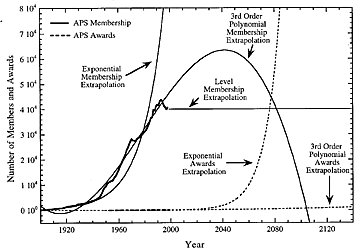Good News for American Physicists
By Scott Sandford
While reading the latest issue of APS News, it struck me that a significant portion of each newsletter was devoted to awards, in the form of articles about those who recently received awards, notifications about fast-approaching nomination deadlines for awards, and announcements of new awards that are just being instituted. Out of curiosity, I connected to the APS Web page and discovered a very well-organized series of pages that provides excellent information about the number and history of the various awards sponsored by the APS.
Figure 1 (below) shows a plot of the number of awards sponsored by the APS as a function of time over the 1950 to 1999 interval. It is apparent that the number of prizes and awards has been increasing monotonically since 1950. In an attempt to predict the trend of increasing awards into the future, I have fit the 1950-1999 award data with both a third-order polynomial function and an exponential function. Both provide reasonable fits to the data, although the third-order polynomial provides a slightly better R value.
 Figure 1 |
Figure 2 (below) shows a similar plot of the total APS membership as a function of time over the 1900 to 1999 time interval, along with the results of similar curve fits. Again, the third-order polynomial provides a better fit than does the exponential, but both provide better R values than I have seen presented with confidence at scientific conferences
 Figure 2 |
It should be noted that, other than awards, one of the main topics that fills the pages of APS News is the current "glut" of physicists in the world market and the consequent difficulty that new PhDs are having finding jobs doing physics. As a result, it is possible that the APS membership may be leveling off. There is some evidence for this in the few years of the APS membership data plotted in Figure 2. Thus, in addition to the extrapolations provided by equations 3 and 4 above, a third possible "extrapolation" of the APS membership into the future would be to assume it maintains a steady value near its current number, i.e., of order 40,000.
Finally, Figure 3 (below) shows a plot of the world population as a function of time over the 1950 to 1998 time interval, along with current estimates of the world's future population. Current UN estimates are that the Earth's population will begin to level off by the year 2050 or so, but estimates of the final value vary from 7.9 to 11.9 billion. In Figure 3, and for the analysis that follows, I will use a value of 10.0 billion. Examination of these three sets of extrapolations, APS awards, APS membership, and world population leads to some startling revelations.
 Figure 3 |
Scenarios
Third Order APS Awards and Exponential APS Membership.
This scenario is perhaps the least favorable for physicists of the future. A quick examination is sufficient to determine that, under these unconstrained conditions, the number of APS members and awards never cross, and there is no expectation of every physicist receiving an award every year, as occurred in the earlier case. Indeed, the number of members pulls rapidly away from the number of awards, and the fraction of APS members who receive awards rapidly drops towards zero. This unconstrained case is unlikely, however, since it predicts that the mass of American physicists will exceed the mass of the Earth sometime around the year 2725 AD. In reality, the number of APS members must ultimately top out when it reaches the total world population. According to the extrapolated world population given in Figure 3, this should occur around April 16, 2200. At this point, with the APS membership leveled out at 10 billion, the third-order increase in awards will begin to overtake the membership and the two eventually cross on April 20th of the year 54199 AD. At this point, every APS member, i.e., the entire world's population, can expect an average of at least one APS award per year.
 Figure 4 |
Third Order APS Awards and Level APS Membership.
The outcome is significantly happier if one assumes a future APS membership that levels off at its current value of order 40,000. In this case, the number of APS awards crosses the APS membership extrapolation on July 24th, 2711, at which point the APS membership is, of course, 40,000. Under these conditions, the one-member-one-award-in-one-year point takes an additional 607 years to occur compared to the first scenario, but it has the advantage that we don't all have to go home four months later.
Exponential APS Awards and Third-Order APS Membership.
This is one of the most favorable scenarios for American physicists. In this case, the number of awards quickly overtakes the number of APS members, and every APS member can expect an average of at least one award per year, starting on August 4th of the year 2077. Also, in this case, at least some of the membership will be able to enjoy their awards for almost 27 years before the Society becomes defunct.
Exponential APS Awards and Exponential APS Membership.
This scenario yields a cross-over of membership and awards on October 5th of the year 2264, at which point the APS would be distributing about 4 x 1011 awards per year. However, as discussed earlier, this cross-over date ignores the fact that the APS membership will have topped out at - and become equal to - the world population of 10 billion in the year 2200. The exponential extrapolation of APS awards reaches the 10 billion value on July 24th of the year 2221, at which point every APS member will again be receiving an average of one award per year.
Exponential APS Awards and Level APS Membership.
This is probably the best scenario for APS physicists as the exponentially increasing number of awards rapidly overtakes the number of APS members and leads to a one-member-one-award-in-one-year point on April 13th, 2076. This is slightly more than a year before the cross-over point predicted by the scenario that uses exponentially increasing awards and a third-order polynomial membership, and it has the added advantage that the APS survives into the next century. The biggest concern may be where to store all the awards, since this case predicts that every APS member will be receiving more than 307,000 awards per year by the year 2100 AD.
Happy Conclusion
Despite the current difficulties associated with new physicists finding employment, the future career prospects of APS physicists looks bright. In all the cases considered, APS physicists can expect their future careers to be very rewarding (or at least very awarding). However, one sole note of caution remains: The APS membership should beware the spectre of the "terminal negative third-order coefficient."
Scott Sandford is a physicist in Santa Clara, California. The above was adapted with permission from an article in the Annals of Improbable Research [March/April 1999]. The original article has been reposted online in honor of the APS Centennial at http://www.improbable.com.
©1995 - 2024, AMERICAN PHYSICAL SOCIETY
APS encourages the redistribution of the materials included in this newspaper provided that attribution to the source is noted and the materials are not truncated or changed.
Editor: Barrett H. Ripin
Associate Editor: Jennifer Ouellette
June 1999 (Volume 8, Number 6)
Articles in this Issue

